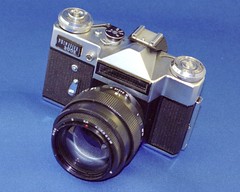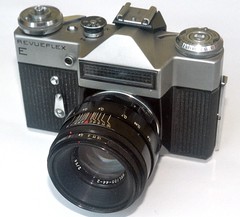Zenit E

|
| image by bottledog (Image rights) |

|
| image by bottledog (Image rights) |
The Zenit E is a Soviet 35mm SLR camera. The first production run took special M39 lenses as prior Zenit models, but all later production runs took the common M42 screw lenses, made from 1965-1968[1]. The Zenit range was quite popular worldwide since it was well-built, if modest in overall specification, and usually priced quite moderately; furthermore it was offered under several other brands outside of the USSR: (Kalimar, Revueflex, Prinzflex, Photokina, Spiraflex, Titan Global[2] and Cosmorex).
Contents

|
| image by steevithak (Image rights) |
Description
The Zenit-E is a smallish and unusual-looking SLR by the standards of the camera market of the time - it appears boxy, but the vertical edges are not as sharp as they look. It is covered in a grippable textured nylon material used extensively in the Soviet camera industry instead of leatherette. It has a wind lever, which is geared to a large frame counter dial that rotates in the opposite direction, corresponding to the advance knob of the earliest Zenits
The rewind knob is hidden. To extract it, apply slight pressure with one fingertip to the gnurled hub of the film-speed dial (on the left hand side, inside the meter dial). Turn the hub counter-clockwise and it will jump out. Pulling further on the rewind knob retracts the fork, but does not open the camera back - it has its own latch on the side.
The Zenit E was produced in both black and brushed white metal finish; and there were commemorative versions for the 1980 Moscow Olympic games with two styles of markings.
Shutter
The interior mechanism is very similar to prior Zenits, and in fact, it is an ultimately Leica II-derived shutter, though with the addition of a mirror and flash sync, with the Zorki S being one of its predecessors. Unlike some prior Zenits, it does have an instant return mirror. The camera offers only shutter speeds of 1/30-1/500, plus B exposure. As is common on flash-synchronized cameras based on the Leica II, synchronization is at 1/30th. The delay can be adjusted continuously from X sync to M sync, but unlike on earlier Zenits and Zorkis the markings in milliseconds are absent (to simplify manufacture, no doubt).
The shutter-speed dial is of the old type: pull up and rotate to set the speed. A small dot on the center of the dial indicates the current setting. It is best for the shutter if this is done while the shutter is cocked, though this is not as vital as it was on earlier Soviet cameras (many of which would break instantly if the shutter was changed while in an uncocked state). The whole dial turns counter-clockwise when cocked and rapidly clockwise when fired.
The shutter can be locked open on "B" if the shutter release button is held down and turned counter-clockwise.
Lens mount
An early production run was made for the Zenit m39 mount, an SLR lens mount with the same threading as the Leica Thread Mount, but a much larger film-to-flange distance. All previous Zenits had taken this mount, which is more or less unique to the series. The second production run used the much more common m42 mount, which has a very similar film to flange distance but larger threads (42mm as opposed to 39mm), allowing the bodies to be otherwise identical. So it remained for the remainder of manufacture.
In neither version is there any aperture coupling - the lens must be stopped down to the correct aperture by hand before firing the shutter. The Zenit EM was an upgraded version, with an automatic diaphragm and a few cosmetic improvements.
Meter
The Zenit E was the first metered camera in the Zenit line - it has a large uncoupled selenium meter built into it, as several Soviet cameras did--readout is by a match-needle display on the top deck. One turns a dial around the rewind knob until a ring in the display is over the needle, at which point, if the film speed is set properly, the photographer can read off a range of equivalent camera settings from the markings on the ring. The meter goes down to 30 seconds shutter opening and f/2, and up to 1/500th and f/32. The exact acceptance angle of the meter is unclear, but it is probably 45 or so degrees.
Export versions are marked with speeds in ASA and DIN, but the ASA scale is oddly numbered - the numbers correspond roughly to common Soviet film speeds, converted from the GOST scale into ASA (the two are measured in extremely similar units and correspond closely, but not precisely), and are usually a little less than a stop off from common international speeds (320 instead of 400, 80 instead of 100, 40 instead of 64, et cetera.) The only common international speed on the dial is 160 ASA, known for being the rated speed of some Portra emulsions.
Name variants

|
| A Zenit E, branded as Prinzflex 500E image by Uwe Kulick (Image rights) |

|
| Revueflex E image by Uwe Kulick (Image rights) |

|
| Kalimar SR 200 (chrome) image by Rick Oleson (Image rights) |
Specifications (from Prinzflex 500E)
- Type: SLR body
- Manufacturer: KMZ
- Film: 35mm, with speeds 16 to 500 ASA
- Lens mount: M39 Zenit mount (z39), then M42 screw mount without aperture coupling.
- Shutter: focal plane textile shutter, speeds 1/30 up to 1/500 sec. + B, synchronized at 1/30th (variable delay, X through M).
- Viewfinder: pentaprism finder, diopter correction lens mountable
- film advance: film advance lever, hidden rewind knob extends out from meter control
- Dimensions:137×92×53 mm
- Self-timer: with own release button and 15 sec. delay-time
Notes
- ↑ Zenit E at www.sovietcams.com.
- ↑ Seen in an online auction May 2012
Links
- User manuals for Zenit E at Michael Butkus Jr.'s
- Zenit E review at 35mmc.com
- Zenit E, Zenit E, Zenit E Olympic on www.collection-appareils.fr by Sylvain Halgand
- Revueflex E (Olympic Games 1980) at Kurt Tauber's